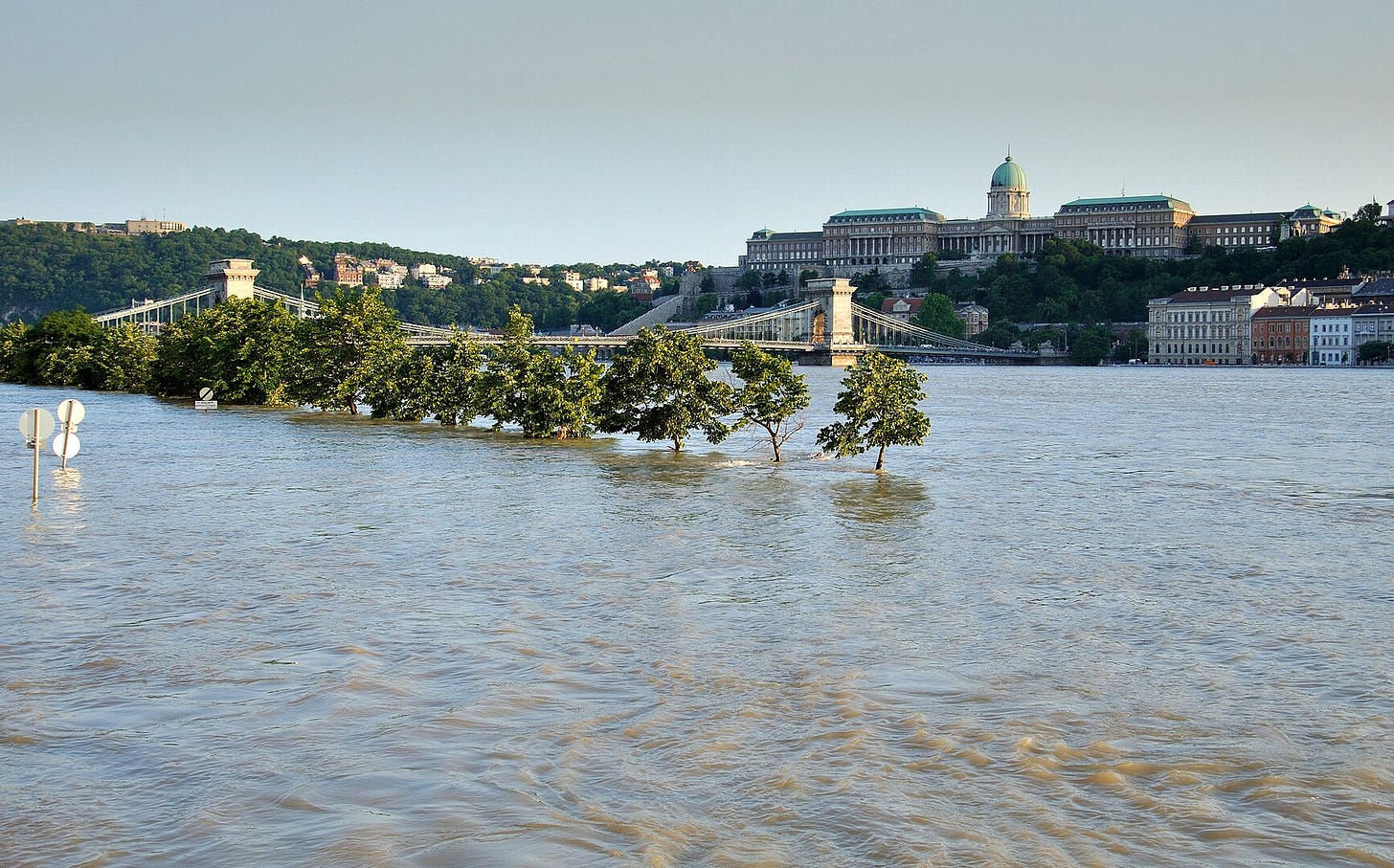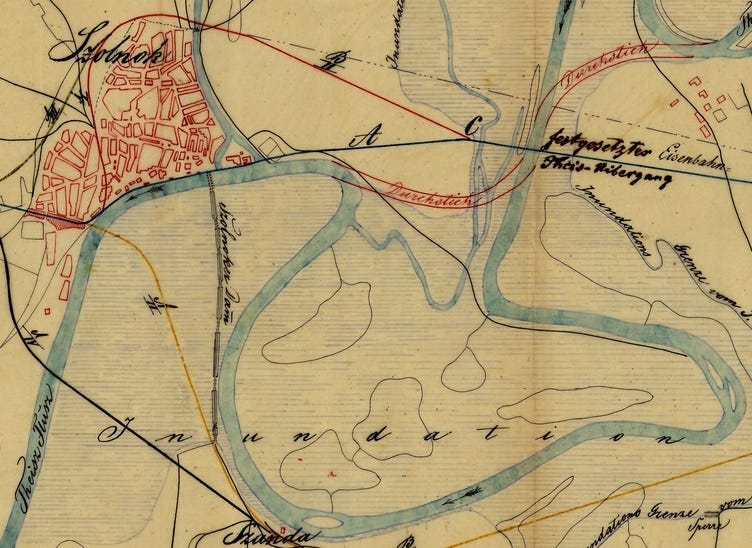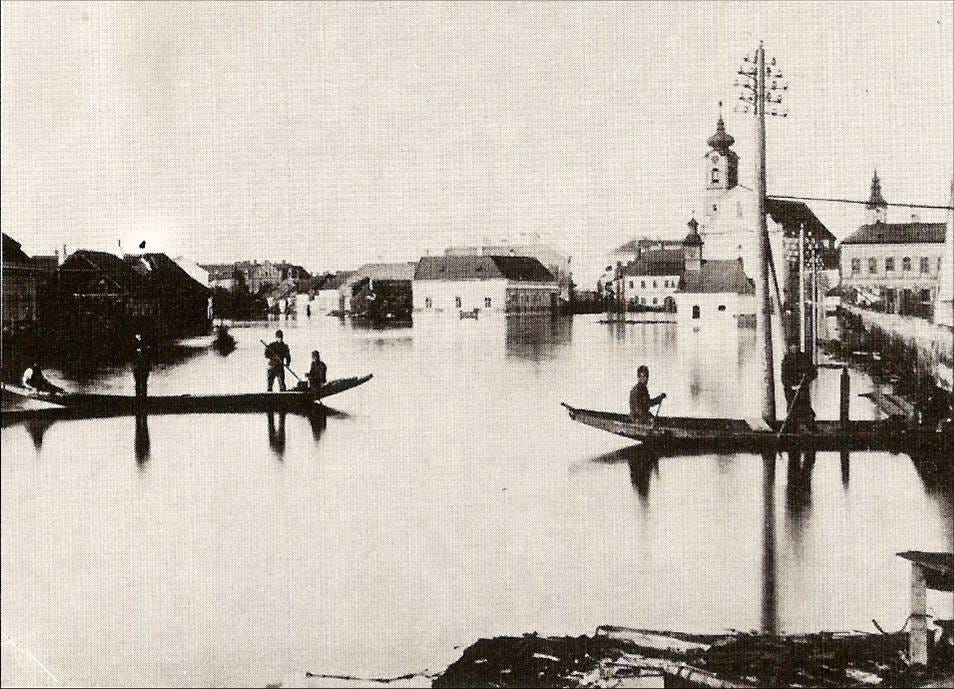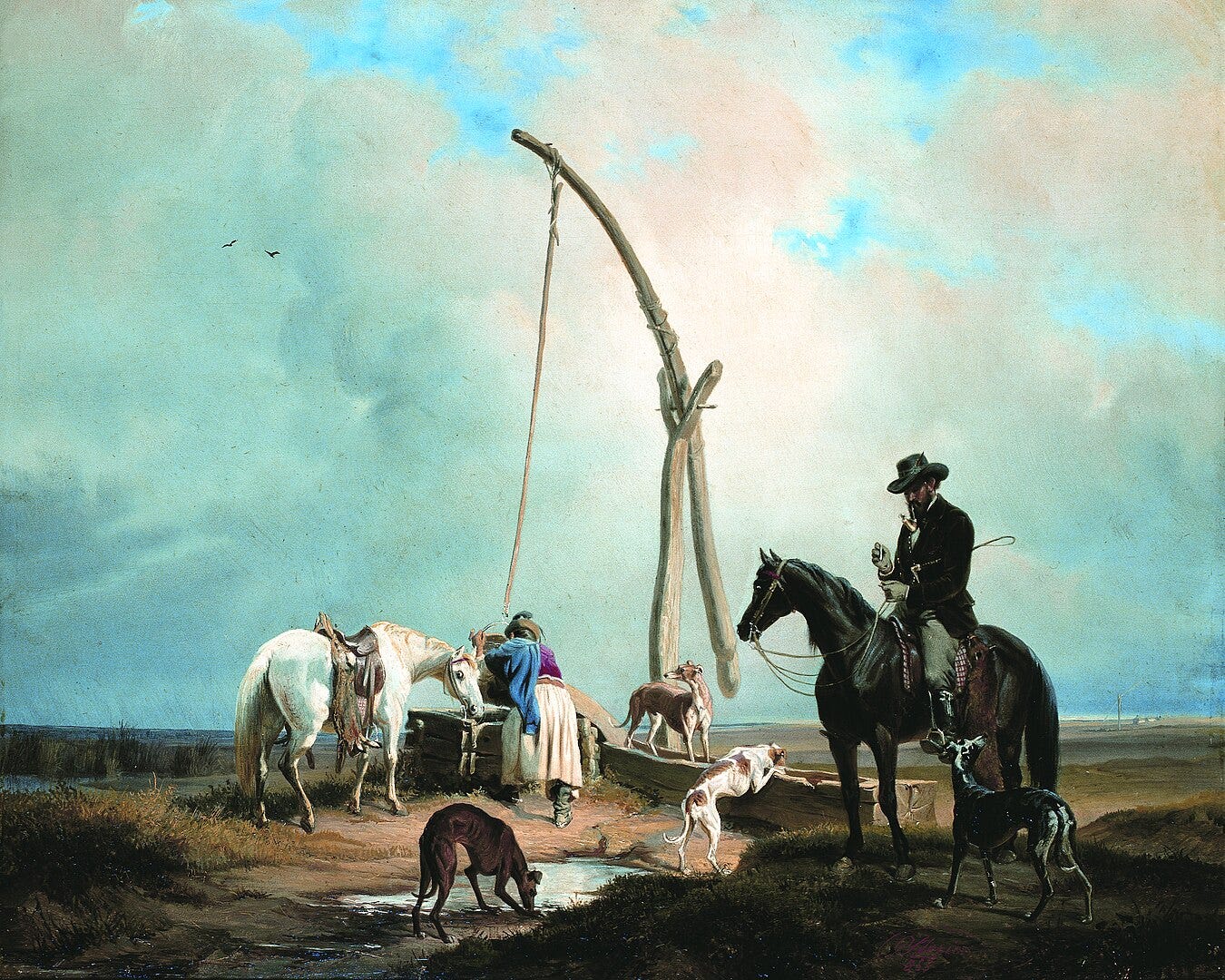Floods are not only alarming, but also magical. Rivers rise out of their beds, lifting us out of stuffy comfort. Mother Nature reveals herself to degenerate city dwellers, turning the embankments into a shimmering sea, reminding us of our diminutiveness in eternity.
Source: Berze Csaba, Wikipedia
Floods, beside having a spiritual dimension, also provide considerable practical use. They are a great opportunity for politicians to show how tough they are. The Very Important Person stomps up the dyke in rubber boots, shakes hands with the common folk, puffs out his chest, expertly and pompously placing some sandbags on the dam. His heroic deeds are filmed with several cameras, as are the questions asked of the locals. A face of grim determination and tender care, serious promises made, reassurances given. Hopping into his jeep he moves on to the next village showing locals how much their lord takes the people’s fate to heart. If there were no floods, they’d have to be invented for PR value. The old masters, Orgyán Virenc and Gyurbán Fektor1, have now been joined by the promise of the future, Petrus Hungaricus2.
Cynicism aside, it is good for the common spirit to fight together against the elements. We’re not checking which war trench someone’s crawled out of, we just feel a presence on our side. A little bit of the old feeling returns: maybe there is an ‘us’ after all. Maybe we, Indians still love each other in the depths of our hearts, here on the largest indigenous reservation in Europe and beyond.
At school we were taught that rivers had to be ‘regulated’ because of recurring, major floods. They didn’t. The old water management system worked fine. The rivers would flood at known times (mainly in the spring), and the appropriate channels would gradually direct the water to safe floodplains, then back into the riverbed. People knew which areas would be permanently dry and safe to build on. They knew where to grow crops, where to plant floodplain orchards, where to have forests, where to graze, and so on. The flood, somewhat like the old Nile, fertilized the land. There were plenty of spawning grounds for fish, which were so plentiful they filled horse carts. There was a spectacular array and number of waterfowl, a dazzling natural wealth in the areas periodically covered by water. This zoomable map shows the original magnificent aquatic world of the Carpathian Basin. Marshes gave people shelter in times of war, nature provided a livelihood from fish, mushrooms, crabs, edible aquatic plants, eggs, extensive livestock breeding and countless other resources.
Source: Wikipedia
If this idyll worked so well, why was river regulation necessary? One reason was urbanization. Around the old city cores, people started to build on flood plains that had previously been left free. This was not the wisest thing to do, but cities attracted people and they settled where they could find space. They didn’t know the nature of the waters, or had forgotten it. And floods came suddenly, unpredictably, sometimes following many peaceful years. After the great flood in Pest in 1838, it was thought that “the task of regulating the Danube could no longer be postponed”. The phrasing is interesting: one will not adapt to nature, but teach it a lesson. This was the beginning of the human ‘we can control nature’ delusion, which later received the trendy name ‘progress’.
Although cities could have been protected at the cost of a more minor alteration to the landscape, there was a much more compelling reason, the advent of capitalism. Landowners cared little for the paradise of egrets and the merry life of marsh people. They wanted money, and to make money they had to grow crops. Wheat and other cereals needed a controllable, dry area. Capitalists also wanted to make the rivers navigable, which meant making them deeper and possibly shorter as well. So they set to work on designing the new Canaan with a pair of compasses and a ruler.
Source: https://szolnok-tisza.blogspot.com/2011/07/jokai-mor-tiszarol-s-szolnokrol.html
They started with the Tisza, shortening its entire length by about 450 kilometres, thinking that the water would run faster. However, the cutting of curves and reduction of the floodplain concentrated a large volume of water to an ever smaller area. The dams that were built were initially not high enough. Also, redesigning started on the upper Tisza, in the territories of poor nobles who coveted farmland. This put even greater pressure on the southern areas, where the dam system was not yet sufficiently developed. In 1879, the dam burst north of Szeged, and the whole settlement, with the exception of the old town core, was flooded. Many people died with only a minuscule number of houses surviving the three-month flood. The entire city had to be rebuilt. River control caused a much greater disaster than before.
Source: Wikipedia
Still, once they started, they wouldn’t stop; next came the regulation of the Danube and other rivers. The Körös rivers, for example, were was cut back to less than half their original length. After raising dams, stagnating water became a problem on agricultural land since water couldn’t make its way into the riverbed. A system of drainage canals had to be built with pumping stations. The next problem was drought so a system of irrigation followed, causing salinization. In many places the natural wonder landscape became a dull, salty wasteland.
Source: Sterio Károly, Wikipedia
A century and a half has passed, and the groundwater level has been sinking ever since. In some places between the Danube and the Tisza it has reached the end — wells have dried up. So far, more than 15 species of invasive cactus have been found in Hungary. How many endemic species of the former marshes have disappeared forever we will never know. Instead of rapidly sending the ever less water down the canals called rivers and wringing our hands over the desertification of the Great Hungarian Plain we should look at some real, long-term solutions.
Because even the floods are still coming. In the 2013 Danube floods, parts of all the settlements in the Danube Bend were submerged. In Vác, the water was at the same height on both sides of the sandbag dam. In Kismaros, even the heating radiators in the house we used to rent were ripped off by the water.
Primary school also explained how, through hard efforts, humans got rid off the sand dunes in the Great Plain. They forgot to mention the small detail that the open sand plains were a result of human intervention. It was most probably triggered by the large-scale deforestation and tilling of land after the expulsion of the Turkish occupiers at the end of the 17th century. The general drying caused by river regulation did not improve the situation. Salinization was brought on directly by river regulation. Hungary had no saline areas before, but when the fields dried up, salt surfaced from deeper layers of the soil.
Source: https://klimastrategia.sandorfalva.hu/hir/aszalyok_szarazsagok-1
There are places on Earth where human megalomania has caused even more trouble. The once nearly 70,000 square kilometre wide Aral Sea has dried up. The Aswan Dam, besides turning the beautiful Upper Nile into a lunar landscape, is acting as a barrier for the famous fertile silt of the river. The recently completed Ethiopian gigantic dam on the Nile will cause Egypt even more severe problems and, despite all the threats, Egypt can not destroy it, even by bombing. Fortunately, improving the situation in our parts is somewhat easier. It’s now clear that we have to redeem the mistake of our fathers. The march of National Heroes and the pile of empty sandbags left on the riverbank after the flood is not the solution.
This somewhat childish video is a good illustration of what needs to be done. If you are interested in more depth, I recommend Balogh Péter ’s study. Although we cannot completely reconstruct the original floodplains, we can gradually start to restore the landscape to a more natural state. A system needs to be developed that can handle the water flow that’s increasingly unpredictable because of climate change. A system that protects people from the sudden influx of large volumes of water, but also captures and stores precious water for times of scarcity. In the process, it will bring back some of the beauty of our former wildlife.
Source: Elsemargriet, Pixabay
The incredible thing is that we can start doing the same in our own back yard. If you live on the tenth floor, it’s a bit tricky. But are you sure you want to live on the tenth floor for the rest of your life? Because even in a small garden, instead of making rainwater flow into the gutter, you can easily capture it. You can store it in a tank, or, much better, drain it back into the ground some distance away from your house. On a slope, the best way to retain water is in swales. It’s worth checking out. All in all, this flood could have been a reminder that we live in the garden of Eden.
Orbán Viktor, prime minister of Hungary and Gyurcsány Ferenc, former PM, a leading opposition figure. There is a long history of public enmity and concealed mutual dependence between the two.
Magyar Péter, leader of a new populist movement interestingly named the Tisza party.








